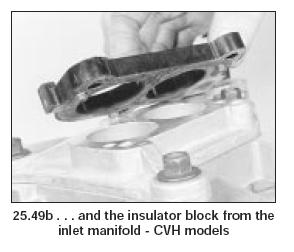MARTY'S DOHC TUNING GUIDE
1. Make sure your engine is in GOOD working order before you start, trying to tune a half shagged engine is a recipe for disaster. Fortunately the 8V DOHC is made of strong stuff and the only weak points are the timing chain and head gasket and these are OK too if changed every 80,000 to 120,000 miles.
2. The head is a very good design and flows very well as stock however that doesn't mean it can't be improved!! Look at the picture below as a rough guide on how to improve things a little. The parts shaded in green is what needs to be removed.
The parts shaded in green is what need to be removed. Similar work also applies to the exhaust side of things. Basically remove the step where the valve seat insert fits into the head and remove any shitty looking bits.
Here you will see the step.

And now the step is gone. See how it all blends together now.

I use a tool like this, take your time and don't removed too much material.

OK that's the ports sorted, next the combustion chamber. They are very good to start with BUT the inlet valve is VERY restricted by the swirl wall (see picture)

This can be sorted by NOT removing it but by altering its shape to allow more flow.

While the head is off regrind the valves and fit new oil seals. There is a modification for the valves too (but I forgot to do pictures) basically what you need to do is smooth the backs of the valves and remove any ridges, there is quite a nasty ridge on the standard inlet valve and this can easily be delt with by putting the valve in a drill and using emery paper. When this ridge is gone there will be a much smoother flow.
Next it to match the ports to their manifolds, I found the standard exhaust manifold is a very good fit but the inlet isn't the best. The picture below will give you a fair idea on what to do.

3. Cams, the standard cams are fairly good and give plenty of low down power. Fitting fast road cams work well in these engines. They make the engine rev more freely. I have fitted some 270° duration cams in my engine and low down power hasn't been affected BUT mid range power seems allot stronger and at higher revs the engine just wants to keep on going.
4. That's the head sorted next is the air filter, this stock filter is fairly restricted. You have a few choices here the cheapest is to drill the stock air box with a series of 1" holes BELOW where the air filter sits. The next step forward after that is to fit a cone type air filter (K&N etc)
5. The exhaust system need to be replaced, ideally a 4-2-1 manifold should be used to give free-flowing extraction of the gases.
If you have a CAT it is vital you remove it, the best option is a performance full system that's fits from the standard down pipe.
6. Fuel. You can up the fuel pressure on the Ford pressure regulator as a cheap and easy way of having better throttle response and ironing out any flat spots. Or if you prefer fit new injectors with a higher flow rate. The standard 2.0 DOHC EFI injectors can provide fuelling for 28.1bhp at 80% load (34bhp approx at 100% load) EACH. What that mean is that if you want more power these injectors are at their limit (running flat out they could provide fuelling for up to 136bhp) What I use is some higher flowing injectors that can provide fuelling for 37.5bhp at 80% load (44bhp at 100% load) If you have a ECU that has a HEGO then that sorts the fuelling out for you with the bigger injectors. The other type would need to be re-tuned with a exhaust gas analyser. DO NOT USE THE FUEL PRESSURE MOD WITH BIGGER INJECTORS!!!! With the higher flowing injectors you have allot more punch to your acceleration. Don't forget to fit a new fuel filter too!
7. Just to get that last bit of power and smooth things out you can fit a ECU chip (Superchip, Powerchip etc) These don't really give the BHP gain they claim BUT the do make the car more 'driveable' and responsive.